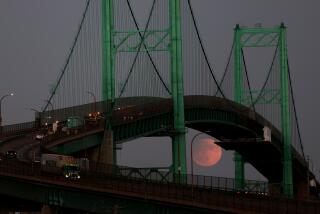Lunar Fanciers Await Tonight’s ‘Once in a Blue Moon’ Sky Bonus
When Griffith Observatory offered a lecture earlier this year on exploring Venus, only 57 people trooped up to the hilltop planetarium to learn about the brightest planet in the solar system. A discussion of Mars drew only 50.
But 10 times that many people attended a talk earlier this month on tonight’s blue moon, a term astronomers use not to describe its color, which will not be affected, but to note the unusual appearance of a second full moon in a single month.
“I want to know everything I can about the moon since I’m a Cancer, a moon child, and the moon charges me up,” said psychologist Nancy Shuler, 48, of Silver Lake. “. . . With two full moons this month, I’ll have lots of energy.”
Beliefs like that are about as logical as thinking the moon is made of cheese, said Griffith Observatory Director Edwin C. Krupp, who discounts theories that link full moons to murder and birthrates and other human events.
Nevertheless, Shuler and others who believe in the power of the moon to influence human behavior are having a field day this month because there are two full moons in May--a relatively unusual occurrence. The first was May 2. Tonight’s second full moon is the blue moon--a nickname of unclear origin.
Actually, Krupp said, the sun and moon have appeared both blue and green on rare occasions because of the scattering of light in the atmosphere caused by dust particles from volcanic explosions and forest fires.
Blue and green suns and moons were widely reported in 1883 and 1884 after the island of Krakatoa near Java exploded, sending volcanic ash into the air. A blue sun was seen in Canada in 1950 after an extensive forest fire in Alberta, according to literature on the subject.
The moon, of course, emits no visible light of its own. The moon simply reflects sunlight. When light in the atmosphere is scattered by uniform particles of a certain size, the transmitted light appears blue.
But an official blue moon such as tonight’s has no link to such scientific rarities and is only a calendar event, Krupp said. It occurs on an average of once every 2 years, 8 months, he said.
Although the origin of the term “blue moon” has not been documented, it is probably related to ancient or medieval sightings of blue-colored moons, said Leroy Doggett, an astronomer with the U.S. Naval Observatory.
It wasn’t until sometime during the 19th Century that the term “once in a blue moon,” which means an event that occurs rarely, was linked to astronomy, Krupp said.
Krupp said that because the moon orbits Earth in about 29 1/2 days, two full moons occasionally occur in the same month. However, they cannot occur in February, which never has more than 29 days, he said.
“The whole thing is just a (calendar) coincidence with no physical significance whatsoever,” said Ronald Lane Reese, a physicist and astronomer at Washington and Lee University in Lexington, Va., who has written about the phenomenon.
Tonight, Los Angeles residents will just have to settle for silvery moonbeams because the moon will not be blue, Krupp said. Yet the “extra” moonlight this month is sure to excite those who associate the full moon with high rates of birth and murder, with insanity, lycanthropy (the curse of the werewolf) and fertility, he said.
“I’m just amazed at the number of people who turned up,” Krupp said. “I suppose the moon does affect behavior to the extent that it is responsible for so many people coming.”
But Krupp maintains that the moon’s influence is limited. During his lecture, he repeatedly cited studies that have shown there is no correlation between the number of births, homicides or admissions to psychiatric hospitals and the full moon or any other phase of the moon.
For example, a study published in the New England Journal of Medicine in 1979 by the late astronomy professor George O. Abell and Dr. Bennett Greenspan concluded that there was no correlation between phases of the moon and the births of nearly 12,000 babies at the UCLA Medical Center from 1974 to 1978.
But nurses at the Mayo Clinic in Rochester, Minn., continue to expect busy nights when the moon is full, said Dr. Dan Broughton, director of community pediatrics at the hospital, who attended Krupp’s talk with his father, who lives in Los Angeles. Several people interviewed after Krupp’s lecture, including Shuler, said they still believe that the moon has a mysterious effect on people.
“We have a relative who hemorrhaged on the full moon,” said Shirley Baron, a property manager from the Los Feliz area. “Maybe it’s coincidental, but I doubt it.”
The tenacity of such beliefs does not bother Krupp, but it infuriates some of his colleagues.
“Our educational system has totally failed if people believe this kind of thing,” Doggett said.
On the other hand, Krupp, who is writing a book about celestial mythology, is fascinated by the ubiquitousness of myths.
“It just goes to show you can’t keep a good story down,” he said. “Harmonic convergence, UFOs, Nostradamus’ predictions--there seems to be a very strong resonance in people’s minds with mythological material, no matter how much we try to suppress it.”
More to Read
Sign up for Essential California
The most important California stories and recommendations in your inbox every morning.
You may occasionally receive promotional content from the Los Angeles Times.










